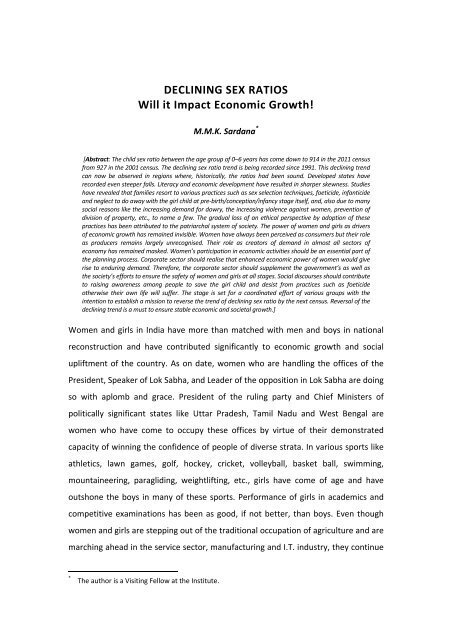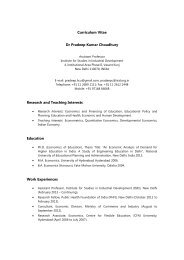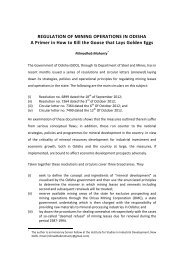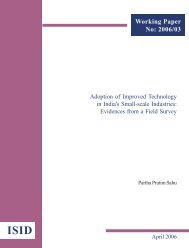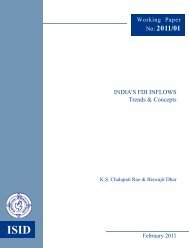DECLINING SEX RATIOS Will it Impact Economic Growth! - BACK
DECLINING SEX RATIOS Will it Impact Economic Growth! - BACK
DECLINING SEX RATIOS Will it Impact Economic Growth! - BACK
Create successful ePaper yourself
Turn your PDF publications into a flip-book with our unique Google optimized e-Paper software.
<strong>DECLINING</strong> <strong>SEX</strong> <strong>RATIOS</strong><br />
<strong>Will</strong> <strong>it</strong> <strong>Impact</strong> <strong>Economic</strong> <strong>Growth</strong>!<br />
M.M.K. Sardana *<br />
[Abstract: The child sex ratio between the age group of 0–6 years has come down to 914 in the 2011 census<br />
from 927 in the 2001 census. The declining sex ratio trend is being recorded since 1991. This declining trend<br />
can now be observed in regions where, historically, the ratios had been sound. Developed states have<br />
recorded even steeper falls. L<strong>it</strong>eracy and economic development have resulted in sharper skewness. Studies<br />
have revealed that families resort to various practices such as sex selection techniques, foeticide, infanticide<br />
and neglect to do away w<strong>it</strong>h the girl child at pre‐birth/conception/infancy stage <strong>it</strong>self, and, also due to many<br />
social reasons like the increasing demand for dowry, the increasing violence against women, prevention of<br />
division of property, etc., to name a few. The gradual loss of an ethical perspective by adoption of these<br />
practices has been attributed to the patriarchal system of society. The power of women and girls as drivers<br />
of economic growth has remained invisible. Women have always been perceived as consumers but their role<br />
as producers remains largely unrecognised. Their role as creators of demand in almost all sectors of<br />
economy has remained masked. Women’s participation in economic activ<strong>it</strong>ies should be an essential part of<br />
the planning process. Corporate sector should realise that enhanced economic power of women would give<br />
rise to enduring demand. Therefore, the corporate sector should supplement the government’s as well as<br />
the society’s efforts to ensure the safety of women and girls at all stages. Social discourses should contribute<br />
to raising awareness among people to save the girl child and desist from practices such as foeticide<br />
otherwise their own life will suffer. The stage is set for a coordinated effort of various groups w<strong>it</strong>h the<br />
intention to establish a mission to reverse the trend of declining sex ratio by the next census. Reversal of the<br />
declining trend is a must to ensure stable economic and societal growth.]<br />
Women and girls in India have more than matched w<strong>it</strong>h men and boys in national<br />
reconstruction and have contributed significantly to economic growth and social<br />
upliftment of the country. As on date, women who are handling the offices of the<br />
President, Speaker of Lok Sabha, and Leader of the oppos<strong>it</strong>ion in Lok Sabha are doing<br />
so w<strong>it</strong>h aplomb and grace. President of the ruling party and Chief Ministers of<br />
pol<strong>it</strong>ically significant states like Uttar Pradesh, Tamil Nadu and West Bengal are<br />
women who have come to occupy these offices by virtue of their demonstrated<br />
capac<strong>it</strong>y of winning the confidence of people of diverse strata. In various sports like<br />
athletics, lawn games, golf, hockey, cricket, volleyball, basket ball, swimming,<br />
mountaineering, paragliding, weightlifting, etc., girls have come of age and have<br />
outshone the boys in many of these sports. Performance of girls in academics and<br />
compet<strong>it</strong>ive examinations has been as good, if not better, than boys. Even though<br />
women and girls are stepping out of the trad<strong>it</strong>ional occupation of agriculture and are<br />
marching ahead in the service sector, manufacturing and I.T. industry, they continue<br />
*<br />
The author is a Vis<strong>it</strong>ing Fellow at the Inst<strong>it</strong>ute.
ISID Discussion Notes<br />
Declining Sex Ratios: <strong>Will</strong> <strong>it</strong> <strong>Impact</strong> <strong>Economic</strong> <strong>Growth</strong>!<br />
to maintain their hold on trad<strong>it</strong>ional arts and crafts. They have proved their mettle in<br />
the adventurous fields of aviation and armed forces. Their contributions in medicine<br />
and science and technology have been as significant as those of men. In the fields of<br />
fine arts, theatre and cinema, women have made a name for themselves and have<br />
earned international recogn<strong>it</strong>ion. Among all nations, Mrs. Indira Gandhi of India was<br />
the first and to date the longest serving female Prime Minister who has left an<br />
indelible mark on the Indian pol<strong>it</strong>y and international affairs.<br />
India’s history abounds w<strong>it</strong>h brave facts detailing illustrious women—women sages<br />
like Gargi and Ma<strong>it</strong>reyi, warriors like Rani Durgavati, Chand Bibi and Rani Jhansi, and<br />
preceptor like Jijabai—who dared to fight all odds. The rise of Razia Begum in the<br />
Sultanate era demonstrates the inherent skill of women to outshine their adversaries<br />
in the most hostile environments. During the freedom movement, the contribution<br />
of women like Kasturba, Annie Beasant, Sarojini Naidu and others is deeply etched in<br />
the Indian psyche.<br />
Women have been accorded a place of honour and worshiped as goddesses of<br />
learning, wealth and destroyer of evil. Men, in order to prop<strong>it</strong>iate gods, worship the<br />
virgin goddesses—who represent pur<strong>it</strong>y and innocence—w<strong>it</strong>h reverence.<br />
Even an ordinary woman in an Indian household keeps the family together through<br />
her services as a householder w<strong>it</strong>hout expecting any reward and remuneration. In<br />
economic terms, a woman performs sundry household jobs w<strong>it</strong>hout being paid to do<br />
<strong>it</strong> and the national accounting systems do not include the monetary value of the<br />
household jobs performed. According to an estimate 1 , value of unpaid work is about<br />
30% of State Domestic Product in Haryana and 29% in Gujarat. Share of women in<br />
these percentages are 28% in Haryana and 26% in Gujarat. Thus, ordinary<br />
housewives contribute enormously through their unpaid work at homes on the one<br />
hand and on the other, their fa<strong>it</strong>hful services at home encourage menfolk to go to<br />
work w<strong>it</strong>hout worrying about their households.<br />
1<br />
Pandey, R.N. “Women’s Contribution To The Economy Through Their Unpaid Household Work.”<br />
Web.<br />
2
ISID Discussion Notes<br />
Declining Sex Ratios: <strong>Will</strong> <strong>it</strong> <strong>Impact</strong> <strong>Economic</strong> <strong>Growth</strong>!<br />
Desp<strong>it</strong>e such impeccable credentials, Indian women and girls have not been able to<br />
get an equal space under the sky. Rather, the declining sex ratio for children in the<br />
age group of 0–6 over the succeeding censuses exhib<strong>it</strong>s a growing aversion to the girl<br />
child. In the 2011 Census, this ratio has come down to 914 per 1000 boys from 927 in<br />
2001. Preference for a male child has spread to places that were once neutral about<br />
the sex compos<strong>it</strong>ion of children. 2<br />
Amartya Sen (1990) 3 analysed that a great many more than 100 million women have<br />
gone missing from this planet because of the consequences of worsening gender<br />
ratio in India, China, South Asia, West Asia and North Africa. Sen, on the basis of<br />
research, argued that if men and women receive similar nutr<strong>it</strong>ional and medical<br />
attention and general healthcare, women tend to live noticeably longer than men.<br />
Sen dismissed arguments that sex ratio would be determined by cultural differences<br />
of societies towards gender or by the degree of development of societies. He further<br />
argued that besides the above aggregate factors, the sex ratio would be subject to<br />
many social cond<strong>it</strong>ions. For example, while <strong>it</strong> may be expected that economically rich<br />
countries would have less or no defic<strong>it</strong> of women on account of better nutr<strong>it</strong>ion and<br />
health facil<strong>it</strong>ies, there are poor regions in Sub‐Saharan Africa where women<br />
outnumber men. There are regions like Punjab and Haryana in India where there is<br />
defic<strong>it</strong> of women compared to their poorer counterparts. Thus, economic<br />
development may result in relative worsening of the rate of survival of women.<br />
<strong>Economic</strong> development does not invariably reduce women’s disadvantages in<br />
mortal<strong>it</strong>y 4 . According to Sen, status and power of women in a family differ greatly<br />
from one region to another and these social features would be related to economic<br />
role and independence of women. Employment outside the home and viewing<br />
assets can be important for women’s economic independence and power. This<br />
would affect the perception of respective contributions to the family’s prosper<strong>it</strong>y<br />
and productiv<strong>it</strong>y and in turn determine the degree of gender inequal<strong>it</strong>y even in<br />
2<br />
3<br />
4<br />
“India’s skewed sex ratio: Seven Brothers.” The Economist 7 April 2011. Web. 23 August 2011.<br />
Sen, Amartya. “More Than 100 Million Women Are Missing.” The New York Review of Books 37.20<br />
(1990). Web. 18 August 2011.<br />
1Ibid.<br />
3
ISID Discussion Notes<br />
Declining Sex Ratios: <strong>Will</strong> <strong>it</strong> <strong>Impact</strong> <strong>Economic</strong> <strong>Growth</strong>!<br />
developed countries. In his analysis Sen concludes that in division of a family’s joint<br />
benef<strong>it</strong>s, the cond<strong>it</strong>ions would be less unfavourable to women if:<br />
1. They can earn an outside income;<br />
2. Their work is recognised as productive—such recogn<strong>it</strong>ion would be easier to<br />
achieve w<strong>it</strong>h work done outside the home;<br />
3. They own some economic resources and have some rights to fall back on;<br />
and<br />
4. There is a clear headed understanding of the ways in which women are<br />
deprived, and recogn<strong>it</strong>ion of the possibil<strong>it</strong>ies of changing this s<strong>it</strong>uation, for<br />
example, through the education of women and by participatory pol<strong>it</strong>ical<br />
action.<br />
Advancing the above conclusions, Sen arrived at the conclusion that when women<br />
establish cond<strong>it</strong>ions for higher contributions to the economic growth of the family in<br />
the form of secure job, they have a ‘demonstration effect’ to counter the relative<br />
neglect of girls as they grow up. A female child would also be perceived as economic<br />
secur<strong>it</strong>y and thus would get due recogn<strong>it</strong>ion leading to better care. Sen attributes<br />
the adverse sex ratio in Punjab to the fact that outside employment of women in<br />
Punjab is one of the lowest in the country.<br />
Since Sen’s analysis, three census operations have taken place and India has<br />
qualified as a major emerging economy in the world. A large number of women are<br />
employed in well‐paying secure jobs and are demonstrably contributing towards the<br />
costs of maintaining living standards. Undoubtedly, women have demonstrated that<br />
through educational support for enhancing their knowledge and skills they can play a<br />
crucial role in providing support to their families. However, the trend of declining sex<br />
ratio continues unabated and is spreading across the regions. Girls are still going<br />
missing at an alarming rate. As per the analysis of Sen, there are certain inherent<br />
social underlying causes which make the upward mobile society maintain <strong>it</strong>s aversion<br />
to the girl child.<br />
4
ISID Discussion Notes<br />
Declining Sex Ratios: <strong>Will</strong> <strong>it</strong> <strong>Impact</strong> <strong>Economic</strong> <strong>Growth</strong>!<br />
There have been studies by scholars in different regions of the country covering<br />
almost all the states and union terr<strong>it</strong>ories. In one such study, conducted by Ajinder<br />
Walia 5 to study the practice of female foeticide in Punjab, an attempt was made to<br />
explore the socio‐economic and cultural dimensions of the practice. According to<br />
this study, birth of a girl child is considered a bad investment for future. She is<br />
labelled a ‘consumer’ rather than a producer, and this trad<strong>it</strong>ional view of the Indian<br />
patriarchal society has led to horrid practices like female infanticide and female<br />
foeticide. Major<strong>it</strong>y of the respondents in diverse regions of the State approved of the<br />
practice of foeticide c<strong>it</strong>ing the escalating demands of dowry as the main reason for<br />
<strong>it</strong>. The other reason was the inabil<strong>it</strong>y of daughters to provide social secur<strong>it</strong>y to<br />
parents—since they move out of their paternal homes upon marriage and are<br />
considered a resource through which the in‐laws can attain greater wealth.<br />
Many studies have been undertaken in different regions of the country w<strong>it</strong>h a view<br />
to determining the underlying causes which continue to negatively impact the<br />
efforts (of all governments and civil society)_underway to reverse the trend. A<br />
comprehensive study 6 , spanning five states of India, namely, Karnataka, Tamil Nadu,<br />
Himachal Pradesh, Uttar Pradesh and Uttaranchal shows that “progressive areas” of<br />
India have a lower child sex ratio. The study claims that ill‐focussed development is<br />
triggering a conscious choice to eliminate the girl child from the family. This study<br />
has revealed that in all the above‐mentioned five states, the less prosperous villages<br />
had a healthy ratio while their wealthier neighbours, w<strong>it</strong>h higher indices of<br />
education and development, lodged lesser number of children. There has been a<br />
strong shift from “son preference to active daughter discrimination”. Factors like<br />
nuclear families, high education cost and access to technology contribute to <strong>it</strong>.<br />
Discrimination against girls is much higher where mothers are l<strong>it</strong>erate. In most cases,<br />
l<strong>it</strong>eracy is just confined to formal degrees; mindsets are prim<strong>it</strong>ive. It is easy to detect<br />
the sex of the child w<strong>it</strong>h improved technology and nuclear families make frequent<br />
use of sex determination techniques to do away w<strong>it</strong>h “unwanted” girls. This study<br />
5<br />
6<br />
Walia, Ajinder. “Female Foeticide In Punjab: Exploring the socio‐economic and cultural<br />
dimensions.” IDEA. Web. 30 August 2011.<br />
“New female foeticide study.” Sikh Philosophy Network, Hindustan Times ePaper. Web. 5<br />
September 2011.<br />
5
ISID Discussion Notes<br />
Declining Sex Ratios: <strong>Will</strong> <strong>it</strong> <strong>Impact</strong> <strong>Economic</strong> <strong>Growth</strong>!<br />
also concurs w<strong>it</strong>h Walia in assuring that sons have trad<strong>it</strong>ionally been strongly<br />
preferred to daughters, especially by couples who opt for a single child. They feel<br />
that the returns of cost and time investments in a male child will be much higher<br />
compared to a female child, who eventually moves to her husband’s home after<br />
marriage. This study also underscores the belief that sons carry forward the<br />
bloodline. Further, there is concern about the right of a married daughter to share in<br />
the family property, apart from dowry, which leaves the parents w<strong>it</strong>h l<strong>it</strong>tle or no<br />
savings. Therefore, a ‘son’ is the preferred choice of the proprietor class as also of<br />
the educated and the worldly wise. Social discrimination against women, so deeply<br />
entrenched in Indian society, has been spurred by technological developments that<br />
today allow mobile sex selection clinics to drive into almost any village or<br />
neighbourhood unchecked.<br />
The above state of affairs belies the expectation of Sen that women’s increasing<br />
capac<strong>it</strong>y to find secure employment, to improve l<strong>it</strong>eracy standards and their<br />
increased participation in out‐of‐home social activ<strong>it</strong>ies by outside mobil<strong>it</strong>y, would<br />
improve the chances of survival of the female child. Rather the impact has been<br />
adverse.<br />
Even the well‐meaning campaign of smaller families which is being increasingly<br />
adopted by families of different strata is negatively impacting the sex ratio. Because<br />
of the still dominant patriarchal mindset of the families in India, parents use the sex<br />
selection tests to select the gender of their offspring, and obviously they would<br />
prefer that <strong>it</strong> be a boy than a girl. When people were not accustomed to living in<br />
small families, a larger brood would ensure a somewhat balanced sex ratio, at least<br />
at the time of birth.<br />
One of the obvious consequences of the continued skewed sex ratio would be the<br />
shortage of brides. Sociologists agree that such a state of affairs encourages abuse,<br />
notably in the trafficking, drug abuse and physical violence against women. “Put<br />
bluntly, <strong>it</strong>’s a compet<strong>it</strong>ion over scarce women.” 7 Societies w<strong>it</strong>h adverse female sex<br />
ratio have indicated the presence of customs like polyandry, abduction and purchase<br />
7<br />
Op.c<strong>it</strong>., 2<br />
6
ISID Discussion Notes<br />
Declining Sex Ratios: <strong>Will</strong> <strong>it</strong> <strong>Impact</strong> <strong>Economic</strong> <strong>Growth</strong>!<br />
of women. It is strongly felt that contrary to raising the status of women, adverse sex<br />
ratio would increase the incidence of rape, prost<strong>it</strong>ution and violence against<br />
women 8 .<br />
Due to the shortage of brides, men belonging to the lower social class are pushed to<br />
the receiving end. Women in India are encouraged to move into a higher income<br />
bracket and/or caste, so richer men find <strong>it</strong> easier to get a bride. The poor are forced<br />
into a long or permanent bachelorhood—a status widely frowned upon in India. The<br />
poorer among the farming commun<strong>it</strong>y in Malwa region of Punjab are forced to<br />
practice polyandry for the twin reasons of scarc<strong>it</strong>y of women and for warding off the<br />
fragmentation of smaller land holdings. 9<br />
As stated above, the shortage of women in society leads to violence against women<br />
rather than improving their status. The s<strong>it</strong>uation is made still more complex since<br />
couples do not wish to beget girls as they fear that <strong>it</strong> would be difficult to bring them<br />
up w<strong>it</strong>h dign<strong>it</strong>y and also because of the continued threat of violence they may have<br />
to face. Therefore, the society is caught in a vicious circle. In a recent study<br />
conducted in Haryana by the Centre for Social Research, <strong>it</strong> has been understood that<br />
fear of violence towards women is a cause for female foeticide. The study also<br />
reveals that a woman who has only daughters is a victim of domestic violence<br />
because of her incapac<strong>it</strong>y to have male children 10 .<br />
It has been brought out that throughout human history, young men have been<br />
responsible for the vast preponderance of crime and violence, especially single men,<br />
in countries where status and social acceptance depend upon being married and<br />
having children, as <strong>it</strong> does in China and India. A rising population of single men spells<br />
trouble 11 . There is a correlation between provincial crime rates and sex ratios. Such a<br />
8<br />
Dubey, Leela. “Misadventure in Amniocentesis.” <strong>Economic</strong> and Pol<strong>it</strong>ical Weekly 18.8 (1983): 279–<br />
80.<br />
9<br />
Garg, Balwant. “Draupadis bloom in rural Punjab.” The Times of India, 26 July 2005.<br />
10 “Violence towards women cause for female foeticide.” Times of India 3 September 2011. See also,<br />
Jha, Durgesh Nandan. “Sex detection: 2 south Delhi clinics raided.” Times of India 3 September<br />
2011.<br />
11 “Gendercide: The worldwide war on baby girls.” The Economist 4 March 2010.<br />
7
ISID Discussion Notes<br />
Declining Sex Ratios: <strong>Will</strong> <strong>it</strong> <strong>Impact</strong> <strong>Economic</strong> <strong>Growth</strong>!<br />
state of affairs would lead to more author<strong>it</strong>arian policing in an effort to crack down<br />
on crimes and gangs. 12<br />
Governments and civil society in India have taken recourse to legislative measures,<br />
welfare measures and have devised schemes to create pos<strong>it</strong>ive discrimination in<br />
favour of the girl child. The continued decline of the sex ratio among children of 0–6<br />
years, over the succeeding censuses is signalling a ubiqu<strong>it</strong>ous trend. The overall<br />
steep and consistent decline in the ratio mandates serious review in the face of<br />
surveys which rank India as the fourth most dangerous country for women, primarily<br />
due to the high female foeticide and infanticide rates. 13<br />
According to the prevalent view, the social system of patriarchy w<strong>it</strong>h the male as the<br />
primary author<strong>it</strong>y upholds the inst<strong>it</strong>utions of male rule and privilege and mandates<br />
female subordination. Patriarchy manifests <strong>it</strong>self in social, religious, legal, pol<strong>it</strong>ical<br />
and economic organisation of society. It continues to strongly influence Indian<br />
society, desp<strong>it</strong>e the Const<strong>it</strong>ution’s attempt to bring about an egal<strong>it</strong>arian social<br />
order 14 . In patriarchy, a compulsory preference for boys would get built in and there<br />
would be corresponding discrimination against a girl child. The prevalent patriarchal<br />
framework places an ideological bar on the discussion of alternative approaches to<br />
achieve gender equal<strong>it</strong>y. In order to maintain the patriarchal order, ethics are<br />
allowed to fade away and never given serious consideration, and, thinking and<br />
behaviour are cond<strong>it</strong>ioned accordingly. Overall, male chauvinism is detrimental to<br />
women’s empowerment—women as an active agent for development, participation<br />
in and guiding their own development.<br />
The continued failure of the efforts of government and civil society—desp<strong>it</strong>e<br />
comprehensive legislations as well as welfare schemes—should motivate us to think<br />
out of the box and w<strong>it</strong>h an impassioned approach free us from the systemic bias<br />
towards patriarchal interests. Undoubtedly, strict implementation of well‐meaning<br />
legislations and welfare schemes would serve some purpose and should be pursued<br />
12 Ibid.<br />
13 Jacob. K.S. “Sex ratio, patriarchy, and ethics.” The Hindu 29 April 2011.<br />
14 Ibid.<br />
8
ISID Discussion Notes<br />
Declining Sex Ratios: <strong>Will</strong> <strong>it</strong> <strong>Impact</strong> <strong>Economic</strong> <strong>Growth</strong>!<br />
w<strong>it</strong>h vigorous efforts. It is argued that lasting and effective solutions lie in<br />
recognising that the system of patriarchy is causal and needs to be interrogated and<br />
laid bare 15 . This would require exploring alternative approaches for gender justice<br />
thereby reversing the trend towards declining sex ratios.<br />
To deal w<strong>it</strong>h patriarchy in a complex society like ours may be set as the ultimate goal<br />
to address gender issues, but the process would be fairly complex and can take a<br />
long time through dialogues and discussions among the segments of society w<strong>it</strong>h a<br />
view to achieving a system where both men and women have equal status and say in<br />
determining the course of society as well as individual family development.<br />
Alongside, short‐term measures need to be worked out to m<strong>it</strong>igate the existing state<br />
of affairs. There are some hopeful signals, though already faint. Though the sex ratio<br />
has been worsening for decades, the pace seems slow. The figure in 2001 was 1.9%<br />
worse than <strong>it</strong> had been in 1991. The figure in 2011 was 1.5% worse than in 2001—an<br />
improvement of sorts. Even the sex ratio at birth is improving, not worsening. In<br />
2003–05, the figure was 880 girls born per 1000 boys. In 2004–06, <strong>it</strong> rose to 892 and<br />
in 2006–08 to 904. Perhaps they reveal a recent change in Indian att<strong>it</strong>udes towards<br />
the value of daughters 16 . Such signals, though faint at this stage, give rise to a belief<br />
that the s<strong>it</strong>uation may take a turn for the better w<strong>it</strong>h more focus and backed by<br />
reinforcing efforts of all segments of society.<br />
So far the efforts towards gender equal<strong>it</strong>y, including prevention of discrimination<br />
against girls and women, have been largely from the side of government and civil<br />
society groups. Such efforts have been supplemented by advances in medicine and<br />
child care techniques and improved extension services. There have been significant<br />
pos<strong>it</strong>ive outcomes which have been recounted in the introductory paragraphs of this<br />
note. However, the full potential of the fair gender is yet to be harnessed and is<br />
wa<strong>it</strong>ing to be tapped for greater economic growth of the country. Such a potential<br />
must become visible to families, commun<strong>it</strong>ies and the country so that all sections of<br />
society understand that their own welfare lies in the enhancement of the status of<br />
15 Ibid.<br />
16 Op.c<strong>it</strong>., 2<br />
9
ISID Discussion Notes<br />
Declining Sex Ratios: <strong>Will</strong> <strong>it</strong> <strong>Impact</strong> <strong>Economic</strong> <strong>Growth</strong>!<br />
women and girls and accordingly develop personal stakes in raising their number to<br />
a level that corresponds to the natural mix of male and female children.<br />
The real<strong>it</strong>y is that women’s contribution towards the economic status of the family<br />
and towards the country’s development remains invisible to men and women alike.<br />
Women’s contribution to the economy is not clearly articulated. It is still seen and<br />
addressed as a social domain issue. But the fact is that women’s labour contribution<br />
has become the backbone of the Indian economy’s current growth path. 17 They are<br />
the cr<strong>it</strong>ical workers in the lead sectors that are triggering India’s growth rate and<br />
comfortable domestic savings ratio. It is also through supporting their efforts in the<br />
Indian pol<strong>it</strong>ical economy that we can hope to reach some of our declared goals. For<br />
example, women const<strong>it</strong>ute 40% of the agricultural workforce and the percentage is<br />
rising; 85% of rural women workers are in agriculture and at the lowest end in terms<br />
of the drudgery and wages. As men sw<strong>it</strong>ch to non‐farm activ<strong>it</strong>ies, women are<br />
increasingly becoming the primary cultivators, but w<strong>it</strong>hout land rights 18 .<br />
Therefore, achieving growth target in agriculture will depend increasingly on women<br />
and the sustenance of this growth will depend on the efficiency of women farmers<br />
by encouraging them to take ownership of land and property. Government schemes<br />
aimed at boosting agricultural development must focus on women and also on<br />
developing their collective power.<br />
W<strong>it</strong>h social secur<strong>it</strong>y schemes like NREGA assuring decent wages, women’s economic<br />
force is coming to the fore. Such schemes would make the contribution of women<br />
and girls to the family income visible and they would become an economic source,<br />
and not merely a social burden 19 . Extending the logic of Pranab Bardhan 20 explaining<br />
better sex ratio in the eastern part of India over that in the NW part because of the<br />
perceived necess<strong>it</strong>y of girls and women to contribute to paddy cultivation, schemes<br />
17 Jain, Devaki. “Numbers on half the sky.” Karmyog. Web. 11 August 2011.<br />
18 Ibid.<br />
19 Jagannathan, R. “How economics will drive women power.” DNA. Web. 30 August 2011.<br />
20 Bardhan, Pranab. “L<strong>it</strong>tle Girls and Death in India.” <strong>Economic</strong> and Pol<strong>it</strong>ical Weekly 17.6 (1982):<br />
1448–1450.<br />
10
ISID Discussion Notes<br />
Declining Sex Ratios: <strong>Will</strong> <strong>it</strong> <strong>Impact</strong> <strong>Economic</strong> <strong>Growth</strong>!<br />
like NREGA and others—which help increase efficiency of women in agricultural<br />
operations—would bode well for increasing the male‐female sex ratio.<br />
In industry, the unorganised sector’s contribution to overall GDP is 56.71% and<br />
women involved in various modes of production are the main workers, paid and<br />
unpaid. 53% of all women workers are home‐based and 73% of informal workers’<br />
contributions come from home‐based jobs. Further, 44% of all women workers are<br />
involved in unpaid work 21 . Therefore, if a policy instrument impacts on the<br />
contribution of SME’s, say, by way of dereservation, the women’s groups would be<br />
negatively impacted at a stage when their contribution is sought to be made more<br />
visible.<br />
In the export oriented production of goods and services, women are the<br />
predominant group of value adders, whether <strong>it</strong> is in the BPO’s, SEZ’s or in some of<br />
the sunrise industries like garment export firms, processed food and even in service<br />
sectors like hosp<strong>it</strong>al<strong>it</strong>y industry.<br />
Besides articulating the contribution of women to economic growth, <strong>it</strong> has to be<br />
realised that women are the face of consumer power. Women have trad<strong>it</strong>ionally<br />
done most of the household shopping, and, w<strong>it</strong>h more money in their hands their<br />
role as consumers gets enhanced. Surveys suggest than women make perhaps 80%<br />
of consumers’ buying decisions—from healthcare and homes to furn<strong>it</strong>ure and food 22 .<br />
According to the results of a survey that was carried out in Japan, a basket of 115<br />
Japanese companies has been worked out that would benef<strong>it</strong> from women’s rising<br />
purchasing power and changing lives as more of them go to work. It includes<br />
industries such as financial services as well as online retailing, beauty, clothing and<br />
prepared foods. Value of shares of such companies has increased manifold over the<br />
average increase of shares in the stock market. 23<br />
21 Op.c<strong>it</strong>., 17<br />
22 “Women and the world economy: A guide to womenomics.” The Economist 12 April 2006. Web. 23<br />
August 2011.<br />
23 Ibid.<br />
11
ISID Discussion Notes<br />
Declining Sex Ratios: <strong>Will</strong> <strong>it</strong> <strong>Impact</strong> <strong>Economic</strong> <strong>Growth</strong>!<br />
It would make business sense if industrial and service sectors in India recognise and<br />
adm<strong>it</strong> the importance of women and girls as the primary consumers and devise<br />
su<strong>it</strong>able strategies to increase such an influential segment of customers. It should be<br />
understood by the industry and service sectors, as empirical evidence shows, that<br />
women and girls do most of the shopping. They constantly look for ways to spend<br />
their family’s disposable income on furnishing, beauty care, healthcare, etc., and also<br />
on investments in real estate and durables. If the numbers of women in the<br />
population mix contracts, the expansion of consumer base would be adversely<br />
affected. The consumer base, on the other side, would expand faster, if more and<br />
more women join the workforce. Thus, women are not only important producers of<br />
goods and services, but also const<strong>it</strong>ute the influential group of consumers. Thus, the<br />
wheels of economic activ<strong>it</strong>y are driven by women and girls.<br />
Therefore, <strong>it</strong> makes sense that Industry as a whole not only contributes meaningfully<br />
towards ensuring the rightful proportion of women of all ages in the population mix,<br />
but also devises meaningful programmes thus making them highly employable in<br />
various segments of the economy as per market requirements. Clearly, engagement<br />
w<strong>it</strong>h women and girls is increasingly cr<strong>it</strong>ical to sustainable growth for every industry.<br />
If the Corporate sector recognises that <strong>it</strong>s own growth depends upon the<br />
contribution of women and children, then they should be making visible efforts as a<br />
part of their social responsibil<strong>it</strong>y to ensure the well‐being of females from the womb<br />
onwards. Industry Associations at the open level and their respective chapters at the<br />
regional levels should be undertaking area specific programmes from their<br />
earmarked resources as necessary investment on their behalf for higher future<br />
returns recognising, in the process, the role of females of all ages in the growth of<br />
industrial and service sectors. UNICEF, recognizing the imperative of investing in<br />
children (read females in particular in Indian context) as a necessary prelude to<br />
economic growth of commun<strong>it</strong>ies, has started involving economists to help highlight<br />
as to how the needs of children could be integrated w<strong>it</strong>h the objectives of<br />
development, and how to extend the horizon of the country’s development plans to<br />
12
ISID Discussion Notes<br />
Declining Sex Ratios: <strong>Will</strong> <strong>it</strong> <strong>Impact</strong> <strong>Economic</strong> <strong>Growth</strong>!<br />
look for ways in which an investment made now could result in significant returns<br />
15–20 years later 24 .<br />
In light of the above, corporate sector should take a serious note of the dwindling<br />
female population over the last century and reflect upon the total accumulated<br />
losses due to the disappearance of more than a million females from the<br />
subcontinent. The corporate sector should be proactive in involving <strong>it</strong>self in the<br />
governmental efforts and civil society in<strong>it</strong>iatives in saving the disappearing girls—<br />
before <strong>it</strong>’s too late. Perhaps this entire decade should be dedicated to this cause<br />
w<strong>it</strong>h the objective of reversing the declining trend by the next census.<br />
India abounds in excellent public communicators who have sway over millions of<br />
men and women. They glorify the ancient Indian culture and provide discourses on<br />
art of living a peaceful and trouble‐free life by assimilating healthier hab<strong>it</strong>s into the<br />
lifestyle, and, detached living. Such communicators, who have been blessed w<strong>it</strong>h the<br />
power of addressing millions, should work towards improving the qual<strong>it</strong>y of their<br />
discourses if they choose to speak on social issues and reviving ethics. The subject of<br />
dwindling population of females and their unequal treatment would surely be an<br />
issue which would beg the attention of such communications. Surely the learned<br />
amongst the social communicators do realise that among the followers, women<br />
steadily adhere to their teachings and also significantly influence their families<br />
(including husbands and children) to swell the ranks. A dwindling female population<br />
may thus have an impact on the strength and qual<strong>it</strong>y of their gatherings in the long<br />
run. Such communicators, through their discourses, aim at creating brotherhood in<br />
the society towards making <strong>it</strong> as orderly as possible. Such objectives would be<br />
countered by such factors as skewed sex ratio in the society which as explained<br />
earlier in this Note would set a chain of events leading to violent behaviours.<br />
Therefore, their learned discourses would be complete in the context of harmony if<br />
they consider including in their addresses issues pertaining to girl child. In the<br />
interest of the society at large, the followers must be told to shun such evil practices<br />
of female foeticide and infanticide otherwise their own lives would remain disturbed<br />
24 Jonsson, Urban. “Children and Society.” The <strong>Economic</strong> Significance of Investing in Children, Chapter<br />
2.<br />
13
ISID Discussion Notes<br />
Declining Sex Ratios: <strong>Will</strong> <strong>it</strong> <strong>Impact</strong> <strong>Economic</strong> <strong>Growth</strong>!<br />
for being part of such unpardonable crimes. No amount of yogic discipline or<br />
abstinence would be of any avail.<br />
The concerns regarding declining female population in India is to rise above the<br />
social domain issue to become a pol<strong>it</strong>ical, economic and reformist issue and the<br />
entire society must be sens<strong>it</strong>ised. We are living through a ‘civilization crises’. The<br />
challenge can only be met by all‐round realisation that even in the patriarchal set up,<br />
<strong>it</strong> is essential to maintain a natural balance between the sexes failing which not only<br />
the social system, but also entire economic system would get damaged beyond<br />
repair. In order to marshal support of various groups and channelising the efforts in<br />
a focussed manner, government may take a lead in establishing a mission for<br />
balancing the sex ratio by the next census operation through a coordinated mix of<br />
reinforcement programmes and support mechanism.<br />
14


